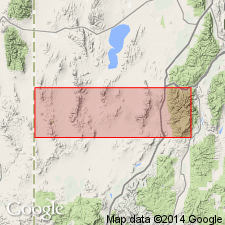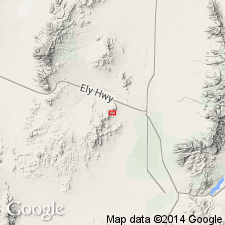
- Usage in publication:
-
- Williams limestone member
- Modifications:
-
- Named
- Dominant lithology:
-
- Limestone
- AAPG geologic province:
-
- Great Basin province
Summary:
Named as member of Harrington formation in Harrington-Hickory mine area, Beaver Co. UT. Lower part of limestone member (approximately 150 ft) contains lenses of fine to coarse-grained quartzite. Member is approximately 600 ft thick. Overlies bed of quartzite approximately 300 ft thick which in turn overlies Rebel limestone [new name]. Underlies series of interbedded silicified limestone and thin-bedded shales. Age given as Triassic.
Source: GNU records (USGS DDS-6; Menlo GNULEX).

- Usage in publication:
-
- Williams Limestone
- Modifications:
-
- Revised
- Age modified
- AAPG geologic province:
-
- Great Basin province
Summary:
Occurs in Rebel mine area in sec.9 T28S R11W, Beaver Co, UT where name is credited to Townsend (1953) [who called unit "Williams Limestone Member" of Harrington Formation (of Triassic age)] in Harrington-Hickory mine area adjacent to Rebel area on the south. Composed dominantly of white recrystallized limestone with few beds of dark gray limestone or dolomitic limestone. Appears lithologically similar to Rebel Limestone (new). Is at least 500 ft thick. Overlies "unnamed" quartzite which in turn overlies Rebel Limestone. [Unconformably] underlies Recent [Holocene] alluvium. Is part of folded and faulted sedimentary sequence of late Paleozoic age.
Source: GNU records (USGS DDS-6; Menlo GNULEX).
For more information, please contact Nancy Stamm, Geologic Names Committee Secretary.
Asterisk (*) indicates published by U.S. Geological Survey authors.
"No current usage" (†) implies that a name has been abandoned or has fallen into disuse. Former usage and, if known, replacement name given in parentheses ( ).
Slash (/) indicates name conflicts with nomenclatural guidelines (CSN, 1933; ACSN, 1961, 1970; NACSN, 1983, 2005, 2021). May be explained within brackets ([ ]).

